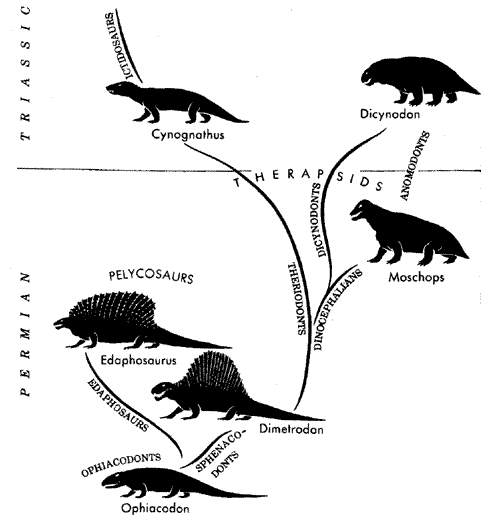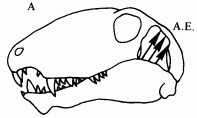
A skeleton of a large carnivorous pelycosaur, Ctenospondylus casei, length 3 meters (photo from Fossilnet Gallery)
| Synapsida | ||
| The Vertebrates | Pelycosauria |
| Vertebrates Home | Vertebrate | Vertebrate |
Abbreviated Dendrogram
Amniota
├─┬─Anapsida
│ └─Eureptilia
│
└─Synapsida
├─Caseasauria
│ ├─Eothyrididae
│ └─Caseidae
└─Eupelycosauria
├─Varanopseidae
└─┬─Ophiacodontidae
└─┬─Edaphosauridae
└─Sphenacodontia
╘═Sphenacodontidae
└─Therapsida |
Contents
Index |
 |
A skeleton of a large carnivorous pelycosaur, Ctenospondylus casei, length 3 meters (photo from Fossilnet Gallery) |
The "pelycosaurs" are the stem group synapsids who inhabited the Permo-Carboniferous. The pelycosaurs were among the very first groups of amniotes to evolve, early in the Late Carboniferous (Pennsylvanian) Epoch. By the end of that epoch all of the major lines of pelycosaurs, except the caseasaurs had appeared. They remained the dominant life-form (the largest, fiercest, etc) for some 40-odd million years, which is about 3/5ths the length of the age of mammals (Cenozoic). They were supplanted by their descendants, the Therapsids or "mammal-like reptiles", which had a short but glorious reign before being decimated by the terminal Permian extinction events, an opportunity that allowed the Archosauria to take over. In their position on the family tree of life, the pelycosaurs are the earliest and most primitive members of the synapsids, the group that (in the old classification) leads to or (in the new classification) includes mammals. Thus the mammal-line split off quite early from the rest of the reptile line, including turtles, lizards and snakes (squamates), crocodiles, dinosaurs and birds.
The evolutionary development of the pelycosaurs are best known and most completely recorded in the fossil record from the Cisuralian and Guadalupian "Red Bed" sediments of North America, particularly in Texas, Oklahoma, and New Mexico. Elsewhere the remains of pelycosaurs are fragmentary and scattered.
 |
Pelycosaur and Therapsid evolution, showing the main types. Mammals evolve from the ictidosaurs (top left). Illustration by Lois M. Darling, from Colbert 1969). |
One distinctive feature of many pelycosaurs is a large sail along the back, formed by the great elongation of neural spines of the vertebrae, sometimes up to a meter in length in the larger species. This condition evolved independently at least three times (and quite possibly more) among pelycosaurs. The function of such spines would seem to be a thermoregulatory device for controlling body temperature. A membrane of skin would span the space between the spines, and this was richly equipped with blood vessels, warming the animal in the chilly morning and cooling it during the midday heat. Thus, in the early morning the animal could stand with its sail oriented toward the sun. Like a solar heater, the sail would absorb heat and warm the blood, which circulated through the body, raising the reptile's temperature so it could begin its daily hunt for food earlier than its non-sailback competitors. To prevent overheating after strenuous activity, it could angle its sail away from the sun and into the wind, dissipating heat. The sail and its associated spines could also have served in sexual and intra-species display behavior, and possibly also for camouflage (e.g. if the animal was hiding among the bamboo-like calamite plants, or giant "horsetails"),
An interesting example of convergent evolution is seen between these pelycosaurs and the unrelated dinosaurs. Several genera of dinosaurs, such as Spinosaurus and Ouranosaurus, both from Gondwanaland during the middle Cretaceous period - developed similar sails on their backs, which may have served a similar purpose.
 But the most distinguishing feature of the Pelycosaurs (and a character retained by their Therapsid descendants) were not their famous sail (which not all pelycosaurs had anyway) but the so-called synapsid skull, which features a single, large opening on the side of the skull (the temporal region) behind the orbit (eye socket). This special opening allowed the development of larger and longer jaw muscles, and hence stronger jaws that could be opened wider and closed forcefully, enabling the animal to dispatch struggling or larger prey. It was this simple evolutionary adaptation that gave the pelycosaurs the edge in the struggle for survival. All that was needed was a prolonged period of drought, such as the sudden period of aridity during the Kasimovian Period, to kill off many of the large stem tetrapods that kept the pelycosaurs insignificant, and these creatures were able to emerge as the dominant life-form on Earth during the Permian period, while the captorhinids remained small and relatively insignificant. MAK, minor revisions ATW090307.
But the most distinguishing feature of the Pelycosaurs (and a character retained by their Therapsid descendants) were not their famous sail (which not all pelycosaurs had anyway) but the so-called synapsid skull, which features a single, large opening on the side of the skull (the temporal region) behind the orbit (eye socket). This special opening allowed the development of larger and longer jaw muscles, and hence stronger jaws that could be opened wider and closed forcefully, enabling the animal to dispatch struggling or larger prey. It was this simple evolutionary adaptation that gave the pelycosaurs the edge in the struggle for survival. All that was needed was a prolonged period of drought, such as the sudden period of aridity during the Kasimovian Period, to kill off many of the large stem tetrapods that kept the pelycosaurs insignificant, and these creatures were able to emerge as the dominant life-form on Earth during the Permian period, while the captorhinids remained small and relatively insignificant. MAK, minor revisions ATW090307.
fr upC.
Synapsida : Caseasauria + * : Varanopseidae + (Ophiacodontidae + (Edaphosauridae + Sphenacodontia)).
Rostrum depth greater than width (i.e. snout width reduced); frontal participates broadly in orbit (at least 1/3 of orbital margin); long, narrow supratemporal; posterior location of the pineal foramen along the interparietal suture; decrease in the length of the skull table and in the length of the parietal relative to the length of the frontal.
010921.
checked ATW050805